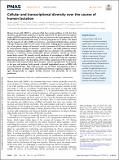Cellular and transcriptional diversity over the course of human lactation
Author(s)
Nyquist, Sarah K; Gao, Patricia; Haining, Tessa KJ; Retchin, Michael R; Golan, Yarden; Drake, Riley S; Kolb, Kellie; Mead, Benjamin E; Ahituv, Nadav; Martinez, Micaela E; Shalek, Alex K; Berger, Bonnie; Goods, Brittany A; ... Show more Show less
DownloadPublished version (2.283Mb)
Publisher with Creative Commons License
Publisher with Creative Commons License
Creative Commons Attribution
Terms of use
Metadata
Show full item recordAbstract
<jats:title>Significance</jats:title>
<jats:p>Human breast milk is the nutritional food source evolved specifically to meet the needs of infants, but much remains to be learned about its composition and changes over the course of lactation. Our description of the cellular components of breast milk, their associations with maternal–infant dyad metadata, and quantification of alterations at the gene and pathway levels provide a longitudinal picture of human breast milk cells across lactational time. These results pave the way for improved therapeutic support of healthy lactation and milk production.</jats:p>
Date issued
2022Department
Massachusetts Institute of Technology. Computational and Systems Biology Program; Massachusetts Institute of Technology. Department of Chemistry; Massachusetts Institute of Technology. Institute for Medical Engineering & Science; Massachusetts Institute of Technology. Computer Science and Artificial Intelligence Laboratory; Ragon Institute of MGH, MIT and Harvard; Koch Institute for Integrative Cancer Research at MITJournal
Proceedings of the National Academy of Sciences of the United States of America
Publisher
Proceedings of the National Academy of Sciences
Citation
Nyquist, Sarah K, Gao, Patricia, Haining, Tessa KJ, Retchin, Michael R, Golan, Yarden et al. 2022. "Cellular and transcriptional diversity over the course of human lactation." Proceedings of the National Academy of Sciences of the United States of America, 119 (15).
Version: Final published version